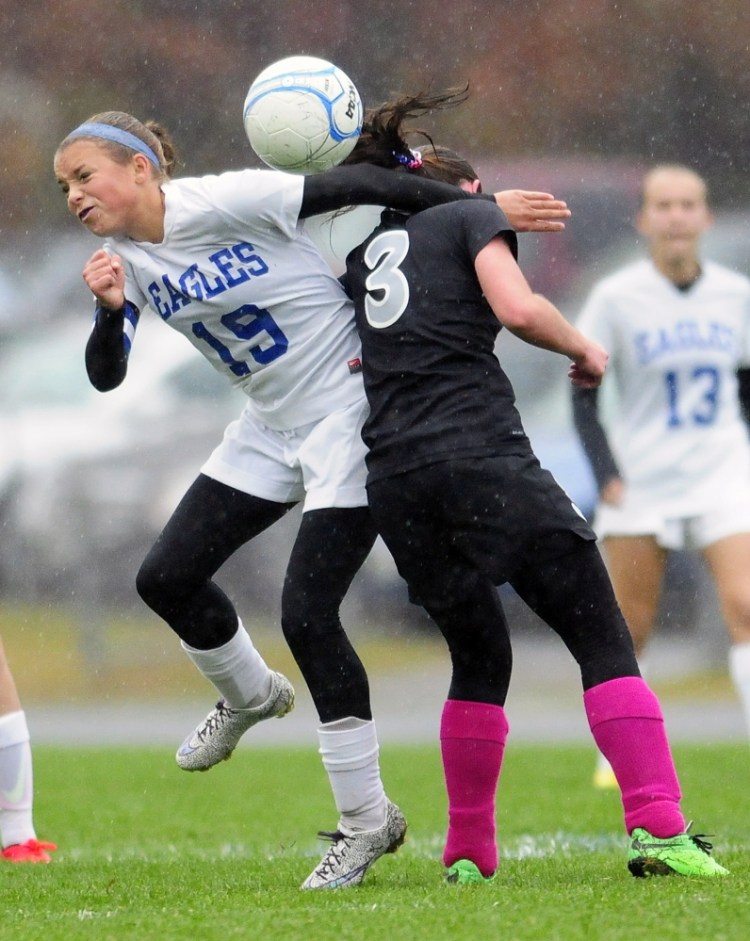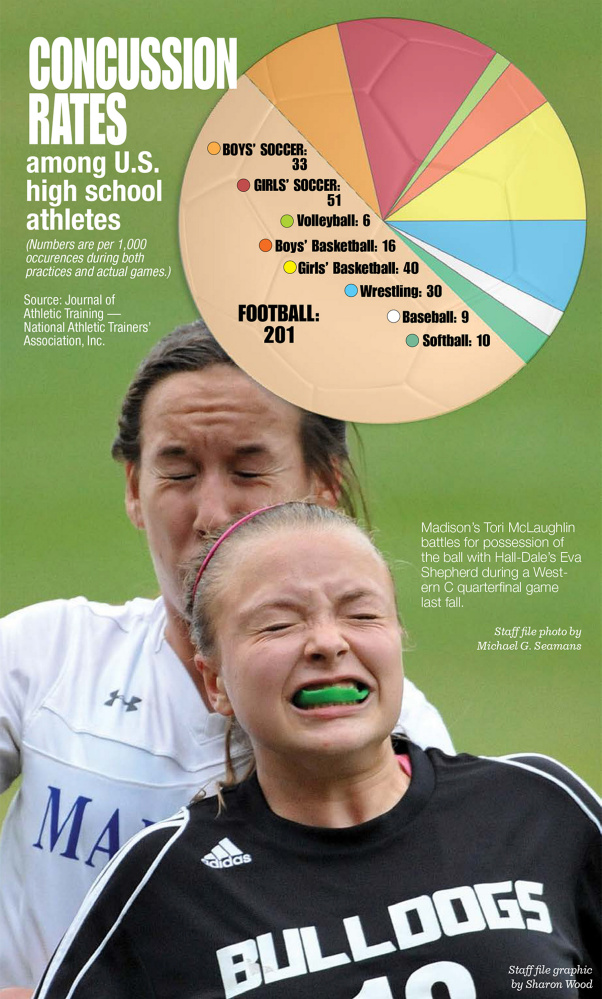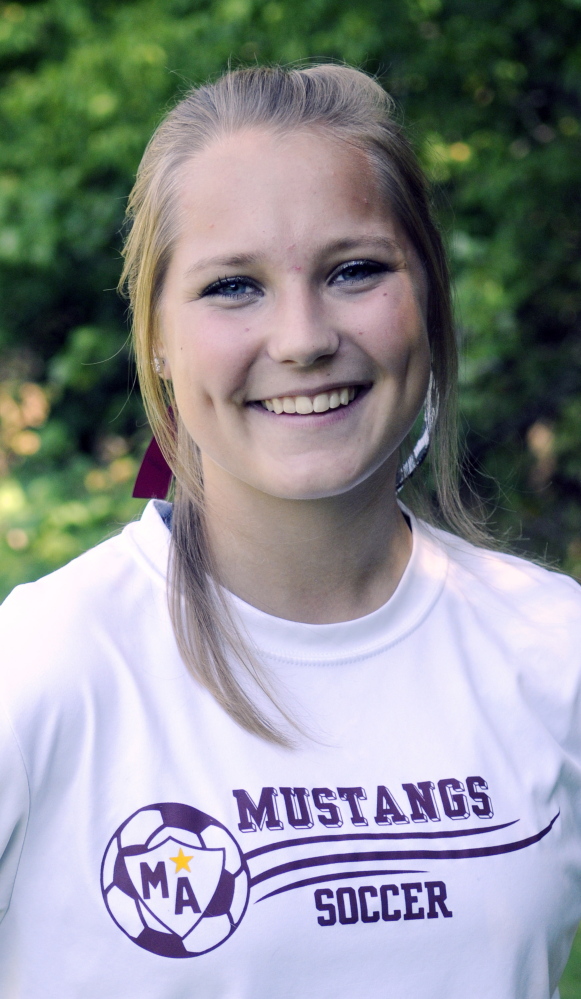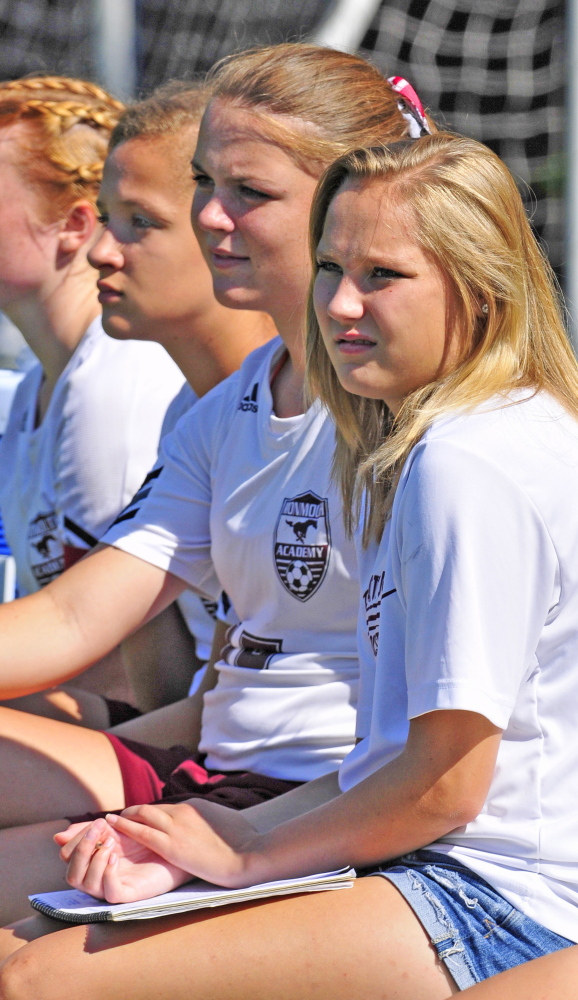Olivia Homer always knew whom she’d defend whenever her Monmouth Academy soccer team stepped on the field.
“The biggest and the fastest,” said Homer, 16, a junior.
Fearless yet standing just 5-foot-2, Homer embraced that challenge.
But after suffering two concussions in a little less than two years, she had to give up the sport she’d loved since kindergarten out of fear for what a third would do to her quality of life.
“Right now, I guess I’m a little worried,” said Homer, who still experiences migraine headaches she attributes to the concussions. “But I’m not as scared as I would be. I think that I’d be more scared if I was playing.”
• • •
Homer says her decision to not play soccer this season was difficult. She and teammate Haley Fletcher dreamed of being team captains for their senior years.
Yet doctors and athletic trainers say athletes who decide not to play a sport after suffering a concussion are making the correct decision if they can’t overcome fears of another one.
But are these fears founded?
A recent High School Sports-Related Injury Surveillance Study shows that concussions are more common in soccer, particularly in the girls game. Furthermore, the data also shows the gap between girls soccer and football is not as wide as commonly perceived.
The survey collected information on 20 sports from 100 American high schools between 2005 and 2014 and found that for every 10,000 “athlete exposures” (times a student-athlete played soccer in a game or in practice), 4.5 girls and 2.8 boys suffered a concussion.
Only football (6.4), boys hockey (5.4) and boys lacrosse (4.0) had higher rates.
In all gender-comparable sports, such as soccer and lacrosse, girls had a higher rate (1.7) than boys (1.0).
Another study from the National Athletic Trainers Association also showed concussions in girls soccer are more prevalent. The national study, which was based on information from the 2005-06 high school sports seasons, showed girls soccer had a concussion rate of 51 (out of 1,000 exposures). Boys soccer, meanwhile, had just 33 while football came in at 201.
Experts say a number of factors could account for the high rate in girls soccer, from physiological and playing style differences to girls possibly being more likely to report a head injury.
Furthermore, athletes who’ve suffered a concussion at any time in their lives have an increased risk of suffering another, according to the Centers for Disease Control.
In soccer, the greatest risk comes from collisions resulting from trying to head the ball and not — as commonly believed — from head-to-ball contact.
“The real problem we’re seeing is athlete-to-athlete contact and, particularly in women’s sports, head-to-head contact, head-to-shoulder, head-to-body contact,” said Tim Weston, head athletic trainer at Colby College and District One director for the National Athletic Trainers Association.
• • •
According to a 2007 report by some of the same Sports-Related Injury Survey authors, only motor vehicle accidents trump athletics as the leading cause of concussions among individuals 15 to 24 years old.
Homer suffered her first concussion in a July 2013 car accident, just days before she was to start soccer practice as a freshman. She missed a couple of games due to headaches but she was mostly symptom-free once school started. She wore headgear through the season with the hopes of preventing another concussion.
She made it through that season and last fall without incident and earned the trust of coach Gary Trafton, who assigned her to mark St. Dominic’s Faith Grady, Madison’s Kayla Bess and other top players in the Mountain Valley Conference.
While playing indoor soccer last March, Homer got knocked down. She got back up and started playing again, only to be knocked down a second time. This time, she fell on her shoulder and her head snapped toward the ground. She remained conscious, but immediately felt dizzy and confused when she got back on her feet.
A doctor in attendance examined Homer. He told her and Susan Norton, Homer’s mother, that he didn’t think she needed to go to the hospital immediately, but recommended they see their primary care physician the next day. He also reminded them to keep a close eye on any symptoms.
Homer’s symptoms worsened overnight and she was diagnosed with a mild concussion the next day.
The symptoms continued to get worse and left Homer confined to her bedroom.
“I had to be in a dark room,” she said. “The lights were so sensitive. It was hard to see. It was hard to think. I just had to lay and do nothing.”
It took her two weeks to get back to school. Even then she could only do half-days at first, and she would spend most of that time alone in a dimly-lit conference room because she was still sensitive to light and noise.
“That’s when I started to realize that sports would be different, school would be different,” Homer said. “The second one hit me so hard. It was diagnosed as moderate, but it felt severe. It took me a while to fully feel better. And I still get headaches. I think from the concussion I got migraines.”
“I just never really came back the same,” Homer added.
• • •
Homer’s story mirrors some of the ones told by pro and amateur football players. Athletic trainers and doctors credit the publicity surrounding brain injuries in American football with raising the public’s consciousnesses of concussions in general. But they believe public perceptions of other sports can end up skewed by football’s high-profile battle with concussions and possible long-term consequences, such as chronic traumatic encephalopathy (CTE).
“The focus on football, I think, has done wonders in terms of saying concussions are important and it’s provided media coverage and resources to the science. But what it really has done is skewed to say football is bad and everything else is good,” said Dr. Paul Berkner, director of the Maine Concussion Management Initiative (MCMI) at Colby College. “We have parents making decisions about concussion risks that are not informed.”
Added Dr. Chris Lutrzykowski, who specializes in non-operative medicine, including concussion management, for Maine General Health in Augusta: “The pendulum has swung from blowing off a possible concussion, and I think it has swung a little too far with parents making choices for kids (out of fear of injuries).”
Nevertheless, coaches, parents and the athletes who’ve suffered concussions are asking questions.
“I see a lot of coaches who are much more educated with regard to concussion management, and parents are as well,” Weston said. “I certainly get more questions from parents like ‘What are the long-term effects for my son or daughter. What is going to happen down the road?'”
Medicine has made great strides in concussion management in just the last decade, and Maine high schools — spurred by a 2012 state law that required them to have a concussion management program — are now more equipped than ever to determine if and when an athlete can return to action.
Many Maine high schools use the program ImPACT, a computerized neurocognitive test that establishes a baseline score for athletes who have been diagnosed with a concussion to match before they can play again. MCMI partners with schools to collect the data, and, with the help of a federal grant, hopes to work with more schools in launching the Head Injury Trauma program, which it says will make it easier for athletic trainers and school officials to record and track concussions.
Baseline testing has its flaws, chief among them being that there is no way of knowing whether test-takers tried their best or simply slacked off to establish a lower baseline score and improve their chances of returning if they do suffer a concussion.
“Pre-concussion testing can be a useful tool, but it’s nowhere near a panacea,” said Chris Sementelli, an athletic trainer for 29 years and program director for Maine General Sports Medicine.
Athletic trainers work closely with schools and sports medicine physicians to help manage concussions, a relationship that has become more common in the state since the 2012 legislation. Public education and media coverage of concussions has athletes, coaches and parents more aware of concussion signs and symptoms, which in turn gives the medical professionals critical information to help the athlete.
“The difference in concussion management has been the improvement in recognizing the signs and symptoms,” Lutrzykowski said. “One of the key pieces of managing concussions is now we’re better able to recognize them.”
Even with access to more information, there is still much medicine does not know about the repercussions of and recovery from concussions. There are many questions a doctor or athletic trainer can’t answer, such as what will happen if an athlete suffers another concussion.
That can cause a lot of uncertainty in a young athlete, and uncertainty doesn’t translate well to the field.
“A key to getting an athlete back to playing after a concussion is working through that piece of fear,” Sementelli said. “I will not let an athlete back on the field unless they have full confidence in themselves.”
• • •
Homer didn’t step near Monmouth’s soccer field when the preseason started and might have avoided it altogether if her coach, Gary Trafton, and her teammates didn’t encourage her to come back as the team’s scorekeeper. She was worried about the temptation to play again.
“I was really close, I think (to trying to play again). At the first game, I started to think, ‘Well, I can be out there. I can play,'” Homer said.
Homer hasn’t missed any school time this year due to her concussion. Without any noticeable symptoms, other students sometimes have a hard time accepting that she has given up her favorite sport.
“She’s had to develop a thick skin,” said Norton, her mother. “She feels like she’s constantly had to defend herself.”
“They think that they would play, but they don’t know exactly what goes on in my head. The headaches I still get sometimes will still feel like I have a concussion,” Homer said.
Norton and Homer said they understand too well how much perceptions about concussions still need to be changed.
“They haven’t had to face their future. You don’t think about it until you’ve had a concussion so bad that it took you out of school,” Homer said. “I’ve had a lot to learn.”
Send questions/comments to the editors.






Success. Please wait for the page to reload. If the page does not reload within 5 seconds, please refresh the page.
Enter your email and password to access comments.
Hi, to comment on stories you must . This profile is in addition to your subscription and website login.
Already have a commenting profile? .
Invalid username/password.
Please check your email to confirm and complete your registration.
Only subscribers are eligible to post comments. Please subscribe or login first for digital access. Here’s why.
Use the form below to reset your password. When you've submitted your account email, we will send an email with a reset code.